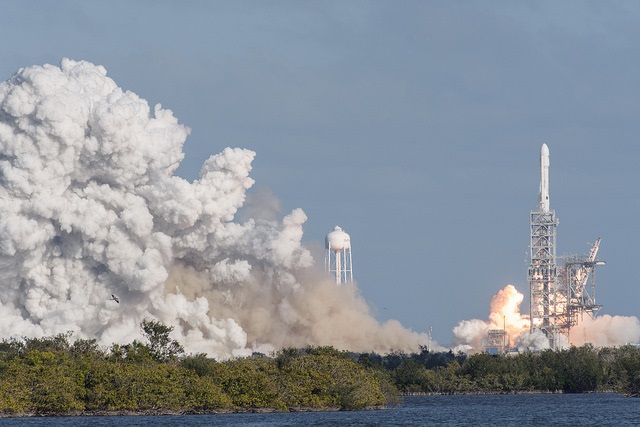
Last week, SpaceX successfully launched its Falcon Heavy booster for the first time from the Kennedy Space Center in Florida. This achievement puts American industry at the forefront of space exploration, proving that where government stalls, the private sector takes over the job of innovation. And they do it at lower costs, with David Bowie blasting in the background.
At 229.6 feet tall, the Falcon Heavy rocket is quickly becoming the most powerful. It has the liftoff thrust of 5 million pounds and capability for more than 140,000 pounds. Competing with this rocket is NASA’s new Space Launch System (SLS), which is being designed to take humans in interplanetary missions. According to CNN, the agency will design new rockets for each new mission. The SLS costs $2.6 billion annually to develop and build the ground launch systems at the Kennedy Space Center. The three year delay of the SLS will add another $7.8 billion to its already costly development. ArsTechnica notes, “That $7.8 billion equates to 86 launches of the reusable Falcon Heavy or 52 of the expendable version.”
In 1969, NASA’s Saturn V rocket brought humans to the moon, and took us back to space throughout the ’70s. While the Saturn V was a breakthrough in human engineering, innovation is on the horizon to take us into the 21st Century of space exploration. SpaceX CEO Elon Musk is now taking that dream of humanity in space to new heights, at lower costs. When the Saturn V was being produced, it cost $1,160,000,000 (adjusted for 2016 inflation) to launch from the Kennedy Center pads. In comparison, the Falcon Heavy costs $90,000,000 to launch, cutting prices 7.8%.
This means that the U.S. can launch 13 Falcon Heavy rockets for every Saturn V rocket launched.
Additionally, NASA tried to do a review of the SLS at the request of the Trump administration to determine whether astronauts would be able to fly on the rocket’s first mission. However, the report found that it would be too difficult, dangerous, and expensive for NASA to pull off in 2019.
Despite this, NASA announced in 2017 that its goal to launch the first SLS would be December 2019. However, this date could be moved due to possible risks, “While the review of the possible manufacturing and production schedule risks indicate a launch date of June 2020, the agency is managing to December 2019,” NASA administrator Robert Lightfoot noted in a statement.
“When you’re talking about the differences in budgets, it’s phenomenal how less expensive Falcon Heavy is compared to a government rocket like SLS,” owner of consulting firm Astralytical Laura Forczyk disclosed to The Verge in a report. Another competitor, the United Launch Alliance’s (ULA) Delta IV Heavy, was also beat on Tuesday by Falcon Heavy’s low cost and high payload. SpaceX’s product can carry at least twice as much as ULA’s at only one-third of the cost. The Falcon Heavy is advertised for $90 million per launch, but the Delta VI Heavy costs between $300 million and $500 million per flight. This cost reduction is significant and exciting for the purchasing power of space exploration.
All this competition makes a clear point—the private market is better at creating innovation to advance human flourishing than government. The market does it at significantly lower costs with exciting new features and entrepreneurial horizons.

